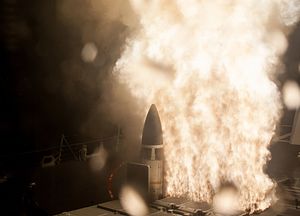The U.S. Department of State (DoS) has approved a possible sale of 73 Standard Missile-3 (SM-3) Block IIA interceptors for an estimated cost of $3.295 billion the U.S. Department of Defense’s (DoD) Defense Security Cooperation Agency (DSCA) said in an August 27 statement.
The deal will include MK 29 Canisters with packing, handling, storage, and transportation kits.
“This proposed sale will support the foreign policy and national security of the United States by improving the security of a major ally that is a force for political stability and economic progress in the Asia-Pacific region,” the statement reads. “It is vital to U.S. national interests to assist Japan in developing and maintaining a strong and effective self-defense capability.”
The SM-3 Block IIA missile is the most advanced version of the SM-3 “hit-to-kill” interceptor series and has been under joint development by U.S. defense contractor Raytheon Missile Systems and Japan’s Mitsubishi Heavy Industries (MHI) since 2006.
Raytheon has been responsible for the SM-3 Block IIA’s hardware, system development, and all-up-round integration. MHI oversees the development of the interceptor’s second- and third-stage rocket motors, steering control, and the missile nosecone.
It can be employed on Aegis-equipped guided missile destroyers and on Aegis Ashore batteries. Japan is expected to acquire two such land-based missile defense systems by 2023.
DoS greenlighted the sale of two Aegis Ashore units to Japan in January 2019. The two batteries will be stationed in Japan’s Akita and Yamaguchi prefectures and next to the SM-3 Block IIA interceptor, are capable of firing the Block IB missile as well as the supersonic SM-6 missile interceptor.
The U.S. Department of State approved a previous sale of eight SM-3 Block IB missiles and 13 Standard Missile-3 (SM-3) Block IIA missiles for an estimated cost of $561 million in November 2018.
The U.S. Missile Defense Agency (MDA) and U.S. Navy last successfully conducted an intercept of an intermediate-range ballistic missile target with a SM-3 Block IIA missile in December 2018.
As I explained at the time:
The December 11 intercept marks the second successful test of a SM-3 Block IIA missile in 2018. On October 26, a SM-3 Block IIA missile launched from the Arleigh Burke-class guided missile destroyer USS John Finn (DDG-113) successfully destroyed a medium-range ballistic missile target launched from the PMRF. A previous successful test of the Aegis Baseline 9/5.1 BMD combat system with a SM-3 Block IIA missile took place in February 2017. Two other tests of the missile in June 2017 and January 2018 ended in failure.
The SM-3 Block IIA is designed to destroy short- to intermediate-range ballistic missiles. “The proposed sale will provide Japan with increased ballistic missile defense capability to assist in defending the Japanese homeland and U.S. personnel stationed there,” the August 27 DSCA statement adds.

































